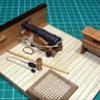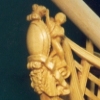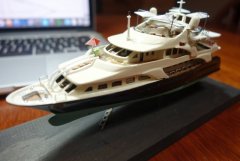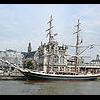Supplies of the Ship Modeler's Handbook are running out. Get your copy NOW before they are gone! Click on photo to order.
×
-
Posts
5,871 -
Joined
-
Last visited
Reputation Activity
-
 BANYAN reacted to rwiederrich in Great Republic 1853 by rwiederrich - FINISHED - four masted extreme clipper
BANYAN reacted to rwiederrich in Great Republic 1853 by rwiederrich - FINISHED - four masted extreme clipper
While the sail was drying...I opted to take another approach to adding the main stay. Instead of rigging them in place I decided to rig them off ship, one side at a time. Then once done I would rig them to the ship and secure them separately...but the connection will look as if it was one connection.
I beefed up the bulls-eye iron strop/hook. Just to let all my concerned citizen MSW folks rest comfortably.
-
 BANYAN reacted to rwiederrich in Great Republic 1853 by rwiederrich - FINISHED - four masted extreme clipper
BANYAN reacted to rwiederrich in Great Republic 1853 by rwiederrich - FINISHED - four masted extreme clipper
Then I finished up the main course by adding the buntlines.....I glued it on the yard.
Rob
-
 BANYAN got a reaction from Rudolf in HMCSS Victoria 1855 by BANYAN - 1:72
BANYAN got a reaction from Rudolf in HMCSS Victoria 1855 by BANYAN - 1:72
Hi folks, I have made some progress on the winches, with the parts now all turned, photoetched etc. I have managed to put the ironwork (brass) for one of them together but still to add the wooden 'bed'. The photos show the progress as I went along but still a lot of cleaning up to do. Most of this is fine metal powder, but a few 'dags' here and there to fix.
The whole assembly is only 15mm long by 11mm high. The small handwheel was purchased but the rest of the parts including the larger hand wheel, except the tapered drum which I turned, are PE that I drew up and had etched. The slightly grooved effect n the drum is deliberate as it had grooves for the first turns of the wire to lay up into. I have styled this after a winch illustrated in Underhill's 'Masting and Rigging the Clipper Ship and Ocean Carrier'.
The cog wheel is two pieces of .2mm bras with tiny alignment holes which allowed me to solder them together and keep the teeth aligned. The worm gear is still beyond my skills so I simply used some brass tube (1.5 mm). The other handwheel is set into a short length of 1.0 mm tube, which is then partially inserted into some small brass square section, to represent the gear box for the drum brake, which is made from thin copper (bends more easily).
The small ding in the tapered wire drum is bigger than planned but is intend as a 'flat' to let me drill through as a starting point for the steel wire rope that will be attached. The halliards (steel wire) were bent to the winch and remained there permanently with the tension held by the drum brake. My next problem is to work out how to fit this strongly enough to allow me to create a 'little' tension on the scaled halliards without pulling the winch away from the deck.
cheers
Pat
-
 BANYAN reacted to michael mott in Bristol Pilot Cutter by michael mott - 1/8 scale - POF
BANYAN reacted to michael mott in Bristol Pilot Cutter by michael mott - 1/8 scale - POF
Ah you mean like these only in green.
These are on a 7/8ths scale inspection loco the levers on the sides turn the loco on and off and forward and reverse it is about 8 inches long and runs on 45mm gauge track.
Michael
-
 BANYAN reacted to michael mott in Bristol Pilot Cutter by michael mott - 1/8 scale - POF
BANYAN reacted to michael mott in Bristol Pilot Cutter by michael mott - 1/8 scale - POF
Thanks for the kind comments Mark.
Last evening I was contemplating the way the cockpit looked and thinking about comfort etc. so did a bit of shifting things around raised up the top edge so that it is 11 inches above the deck and rough blocked in some seating which will have a couple of small tip out lockers under them. I want to keep the seats as a solid surface.
First i took the earlier floor grating and rotated it 90 degrees to give me the width and cut the angled sides off with the jewelers saw then cleaned it up on the shooting board.
Then roughed out a few scraps of Mahogany to sort out the shape of the seats, the final will be the same thickness obviously and a full 1inch thick (1/8th) The lower woodwork under the seats will also be mahogany and the lockers will open.
Hmm... I still need to finish the cover for the compass.
Michael
-
 BANYAN got a reaction from popeye the sailor in HMCSS Victoria 1855 by BANYAN - 1:72
BANYAN got a reaction from popeye the sailor in HMCSS Victoria 1855 by BANYAN - 1:72
Thanks again Eberhard, you are a fountain of knowledge on these matters. I am still tempted to replace them and am leaning more and more towards doing so before I start painting them, and then it will all be too late.
cheers
Pat
-
 BANYAN got a reaction from hexnut in HMCSS Victoria 1855 by BANYAN - 1:72
BANYAN got a reaction from hexnut in HMCSS Victoria 1855 by BANYAN - 1:72
Hi folks, another small update. Now that I have the PE in hand I can progress on a bit; still waiting for the 3D parts (capstan and revised funnel). I also had some laser parts cut for the engine room skylight as my attempts to make them kept breaking (stiles and rails) as the walls are only .6mm thick and the rails /stiles just .8mm. They have come up OK considering the size.
One of the reasons for lack of updates is that I had been busy drawing up all these part. The two sheets of PE are 0.4mm (larger sheet) and 0.2mm.
I am in the process of doing the glazing and have added the 'waffle' style ventilation louvres discussed earlier. The louvers were made from 0.2mm thick brass sheet and folded and soldered to get the effect seen in the photo earlier - they look OK I think? My biggest decision is whether to add another louvre in the front and after walls. I show a blank and a louvre version in the photos, but have an additional one of each.
My thoughts are to go for blank (no louvre) as I think there would have been adequate ventilation from the louvres and top pieces? The reasoning is that the after wall would most likely have been used to store the firehose racks, and supplementary 'L' shaped handle for the Downton pumps (only shipped as required.
I have started on the rod/bar grills for the top pieces with the parts shown before cleaning (one made, one unmade); the rods are only 0.6mm diameter. These have since been blackened but I forgot to take a photo. When the glazing in the top pieces have dried completely these will be glued over the windows / glazed parts.
I have also made the bases for the pumps, and manufactured one of the two suction plate assemblies required. The idea was that the connecting pipe(rounded/horseshoe shape) could be cross-connected to any one of three suction pipes (one to each major compartment/space). The top end of the pipe ran underdeck between the pipe and this plate assembly. I still have a 7" hose connection plate (single) to make which was the upper deck connection to the pump in the engine room (for firefighting) whereas the other two are for dewatering and transferring freshwater around the ship. The wood looks rough but I am zoomed right in and actually looks very smooth to the eye.
The 'pelorus' has also been completed. The 'hollow' look of the brass night cover for the compass is a trick of the light as I have painted that face silver to simulate the viewer.
These parts will be fitted once the engine room skylight has been fitted.
cheers
Pat
-
 BANYAN got a reaction from popeye the sailor in HMCSS Victoria 1855 by BANYAN - 1:72
BANYAN got a reaction from popeye the sailor in HMCSS Victoria 1855 by BANYAN - 1:72
Thanks Denis and Ed, appreciate the feedback.
Denis, saves me on the mental 'gymnastics' also
Ed, appreciate that coming from you; I have a long way to go to match your skills though In hindsight, there are two things I would change; one I am considering making.
I should have used another thickness (or two) of the large cog in the laminated approach I have taken (there are only two of 0.2mm) which would have made it looks a little more substantial and represent the real thing a little better. The other is that I should have used a cut-off section of a very fine thread small bolt for the worm gear. I am tempted to replace it but do not want to risk destroying other work with applying yet more heat to desolder and resolder the worm drive. Lesson learned for next time at least.
cheers
Pat
-
 BANYAN got a reaction from mtaylor in HMCSS Victoria 1855 by BANYAN - 1:72
BANYAN got a reaction from mtaylor in HMCSS Victoria 1855 by BANYAN - 1:72
Thanks again Eberhard, you are a fountain of knowledge on these matters. I am still tempted to replace them and am leaning more and more towards doing so before I start painting them, and then it will all be too late.
cheers
Pat
-
 BANYAN got a reaction from popeye the sailor in HMCSS Victoria 1855 by BANYAN - 1:72
BANYAN got a reaction from popeye the sailor in HMCSS Victoria 1855 by BANYAN - 1:72
Hi Eberhardt, appreciate you feedback also, again I have a long way to go to match your machining skills. Sorry, I thought I had answered your question.
My intention in the text was to infer that I used brass to represent the iron as it is easier to work at at this scale. I am confident they were used as the Contract called for them and my research (Underhill in particular, but others) show they were being introduced as early as the 1850s but mainly in the mercantile ships, in particular clippers. Victoria used them as they were minimum manned.
It was of interest that in letter written by Commander Lockyer (build superintendent) as a progress report to the Colony's governor (Sir Charles Hotham - a RN Naval Officer also) that I found in the Public records Office, it states:
In this vessel I am continuing all the newer, and well tried, improvements that have been adopted in Her Majesty’s Service and in the Mercantile Navy.
This verifies earlier assumptions that 'cutting edge' technology for that time was being fitted.
cheers
Pat
-
 BANYAN got a reaction from EdT in HMCSS Victoria 1855 by BANYAN - 1:72
BANYAN got a reaction from EdT in HMCSS Victoria 1855 by BANYAN - 1:72
Thanks Denis and Ed, appreciate the feedback.
Denis, saves me on the mental 'gymnastics' also
Ed, appreciate that coming from you; I have a long way to go to match your skills though In hindsight, there are two things I would change; one I am considering making.
I should have used another thickness (or two) of the large cog in the laminated approach I have taken (there are only two of 0.2mm) which would have made it looks a little more substantial and represent the real thing a little better. The other is that I should have used a cut-off section of a very fine thread small bolt for the worm gear. I am tempted to replace it but do not want to risk destroying other work with applying yet more heat to desolder and resolder the worm drive. Lesson learned for next time at least.
cheers
Pat
-
 BANYAN got a reaction from Omega1234 in HMCSS Victoria 1855 by BANYAN - 1:72
BANYAN got a reaction from Omega1234 in HMCSS Victoria 1855 by BANYAN - 1:72
Hi Eberhardt, appreciate you feedback also, again I have a long way to go to match your machining skills. Sorry, I thought I had answered your question.
My intention in the text was to infer that I used brass to represent the iron as it is easier to work at at this scale. I am confident they were used as the Contract called for them and my research (Underhill in particular, but others) show they were being introduced as early as the 1850s but mainly in the mercantile ships, in particular clippers. Victoria used them as they were minimum manned.
It was of interest that in letter written by Commander Lockyer (build superintendent) as a progress report to the Colony's governor (Sir Charles Hotham - a RN Naval Officer also) that I found in the Public records Office, it states:
In this vessel I am continuing all the newer, and well tried, improvements that have been adopted in Her Majesty’s Service and in the Mercantile Navy.
This verifies earlier assumptions that 'cutting edge' technology for that time was being fitted.
cheers
Pat
-
 BANYAN got a reaction from Omega1234 in HMCSS Victoria 1855 by BANYAN - 1:72
BANYAN got a reaction from Omega1234 in HMCSS Victoria 1855 by BANYAN - 1:72
Thanks Denis and Ed, appreciate the feedback.
Denis, saves me on the mental 'gymnastics' also
Ed, appreciate that coming from you; I have a long way to go to match your skills though In hindsight, there are two things I would change; one I am considering making.
I should have used another thickness (or two) of the large cog in the laminated approach I have taken (there are only two of 0.2mm) which would have made it looks a little more substantial and represent the real thing a little better. The other is that I should have used a cut-off section of a very fine thread small bolt for the worm gear. I am tempted to replace it but do not want to risk destroying other work with applying yet more heat to desolder and resolder the worm drive. Lesson learned for next time at least.
cheers
Pat
-
 BANYAN got a reaction from mtaylor in Deck gun cannons
BANYAN got a reaction from mtaylor in Deck gun cannons
I for one am moving down the 3D printing path for the accuracy and level of detail which is consistently repeatable.
cheers
Pat
-

-
 BANYAN reacted to popeye the sailor in HMCSS Victoria 1855 by BANYAN - 1:72
BANYAN reacted to popeye the sailor in HMCSS Victoria 1855 by BANYAN - 1:72
great looking winch Pat.....nicely done
I like the face that the ruler has the numbers printed on it..........it would keep me from having that bewildered look all the time, when I try to figure stuff out in my head
-
 BANYAN reacted to rwiederrich in Great Republic 1853 by rwiederrich - FINISHED - four masted extreme clipper
BANYAN reacted to rwiederrich in Great Republic 1853 by rwiederrich - FINISHED - four masted extreme clipper
I'm lost on the term......?
Rob
-
 BANYAN reacted to SJSoane in Bristol Pilot Cutter by michael mott - 1/8 scale - POF
BANYAN reacted to SJSoane in Bristol Pilot Cutter by michael mott - 1/8 scale - POF
Incredible detail, Michael, even to the orientation of the screw slots. You continue to set the highest standard!
Mark
-
 BANYAN reacted to Louie da fly in 10th-11th century Byzantine dromon by Louie da fly - FINISHED - 1:50
BANYAN reacted to Louie da fly in 10th-11th century Byzantine dromon by Louie da fly - FINISHED - 1:50
Thanks everyone who added a "like".
Grandpa Phil, Goetzi and Patrick, thanks for the comments.
Druxey, what can I say? The two-handed axe is the Queen of the battlefield. Before the battle began a bunch of axemen stood in front of the English line swinging their axes around their heads. I thought it looked a bit Hollywood/Disneyland, but apparently the guys on the Norman side were horrified . . .
Christos, thank you very much. I'm not totally certain I've reached the limit, but I suppose unless I make another figure and try even finer detail, I won't know. I'm still thinking about that one.
Pat; thanks regarding the mail, but I won't be doing any more armoured figures - I did one earlier in the log and this is the only extra I'll be making. The Emperor is usually shown with just two guards and a bunch of courtiers. On the other hand, I still have to make 50 oarsmen, but I'm intending to cast them. Carving's too much work.
I'm going to have to do a fair bit of design work for the siphon. Might take awhile.
Steven
-
 BANYAN reacted to Louie da fly in 10th-11th century Byzantine dromon by Louie da fly - FINISHED - 1:50
BANYAN reacted to Louie da fly in 10th-11th century Byzantine dromon by Louie da fly - FINISHED - 1:50
I've been working on the forecastle and have started thinking about the Greek Fire projector or siphon which will be mounted on it. There's been a lot of work done on theoretical reconstructions of the siphon, particularly by John Haldon who is probably the world authority on the subject, having worked on it for 25 years. Here's a Youtube video of a reconstruction in action to John Haldon's plans, even using the light grade crude oil from central Turkey that was available to the Byzantines.
Funny thing is, an independent guy called Richard Windley (?) made a reconstruction in 2008
which has considerable advantages, particularly in that it can be operated by a single person. In Byzantine times only a single crew member, one of the lead oarsmen - was the siphonator, with the duty of operating the projector.
However, this reconstruction doesn't have a brazier heating the oil, he uses a modern fuel and the directing mechanism seems a bit frail. And unless I've missed something, though his reconstruction is obviously based on Haldon's design he doesn't seem to give Haldon credit.
Very worthwhile information in both, and I'll be ensuring the shielding against heat and fire is of a similar level to these. My own model will combine aspects of both these designs. But it won't be made workable - I'm not completely nuts.
Steven
-
 BANYAN got a reaction from popeye the sailor in Great Republic 1853 by rwiederrich - FINISHED - four masted extreme clipper
BANYAN got a reaction from popeye the sailor in Great Republic 1853 by rwiederrich - FINISHED - four masted extreme clipper
Ditto Keith's last comment
cheers
Pat
-
 BANYAN got a reaction from hexnut in HMCSS Victoria 1855 by BANYAN - 1:72
BANYAN got a reaction from hexnut in HMCSS Victoria 1855 by BANYAN - 1:72
Hi folks, I have made some progress on the winches, with the parts now all turned, photoetched etc. I have managed to put the ironwork (brass) for one of them together but still to add the wooden 'bed'. The photos show the progress as I went along but still a lot of cleaning up to do. Most of this is fine metal powder, but a few 'dags' here and there to fix.
The whole assembly is only 15mm long by 11mm high. The small handwheel was purchased but the rest of the parts including the larger hand wheel, except the tapered drum which I turned, are PE that I drew up and had etched. The slightly grooved effect n the drum is deliberate as it had grooves for the first turns of the wire to lay up into. I have styled this after a winch illustrated in Underhill's 'Masting and Rigging the Clipper Ship and Ocean Carrier'.
The cog wheel is two pieces of .2mm bras with tiny alignment holes which allowed me to solder them together and keep the teeth aligned. The worm gear is still beyond my skills so I simply used some brass tube (1.5 mm). The other handwheel is set into a short length of 1.0 mm tube, which is then partially inserted into some small brass square section, to represent the gear box for the drum brake, which is made from thin copper (bends more easily).
The small ding in the tapered wire drum is bigger than planned but is intend as a 'flat' to let me drill through as a starting point for the steel wire rope that will be attached. The halliards (steel wire) were bent to the winch and remained there permanently with the tension held by the drum brake. My next problem is to work out how to fit this strongly enough to allow me to create a 'little' tension on the scaled halliards without pulling the winch away from the deck.
cheers
Pat
-
 BANYAN got a reaction from Louie da fly in 10th-11th century Byzantine dromon by Louie da fly - FINISHED - 1:50
BANYAN got a reaction from Louie da fly in 10th-11th century Byzantine dromon by Louie da fly - FINISHED - 1:50
I would say that is a pretty good effort Steven, I think the overall effect is there - it is distinctive and infers mail cladding. I look forward to seeing your small 'army' complete
cheers
Pat
-
 BANYAN got a reaction from Chasseur in Bristol Pilot Cutter by michael mott - 1/8 scale - POF
BANYAN got a reaction from Chasseur in Bristol Pilot Cutter by michael mott - 1/8 scale - POF
This will be one-stunning model Michael. I love the detail and quality of the work.
cheers
Pat
-
 BANYAN got a reaction from Canute in Another way to make shackles
BANYAN got a reaction from Canute in Another way to make shackles
Those eccentric pins are a great idea Wefalck, certainly better than a normal pin. I also like the idea of the former you use - clever idea for those sorts of parts.
cheers
Pat










